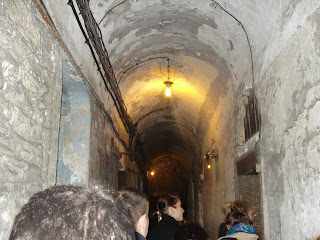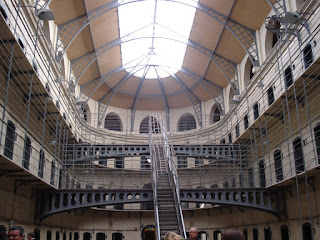Belfast
Friday
We got in late afternoon. We went directly to a really cool pub (Crown Bar) for drinks. It was very ornate inside with little private booths. For dinner, we went to an Italian restaurant. Since it was Friday, I decided to be a good Catholic and order the salmon. It was very good! After, we changed and went out dancing at a club till early the next morning. This was a common theme throughout the trip, which may be why I'm so tired.


Saturday
After waking up late and grabbing some breakfast we headed for the walking tour Eric (my friend from the Academy who is studying in Belfast) had arranged. The first tour was a Coiste Tour by an ex-IRA terrorist and former prisoner starting at Divis Tower and headed up Falls Road. We also stopped at the Irish Republic History Museum. The museum is home to a collection of artifacts and prison handicrafts, representing the various phases of the struggle for Irish Freedom. Included are many items dating back to the Rebellions of 1798 and 1803, medals from the 1916-1923 period, as well as personal items from the various periods of imprisonment endured by Irish Republicans in every decade since. I learned a lot about the history of Belfast and Ireland as a whole. I had no idea the tensions were still so recent and the Catholic and Protestant sides of the city had to be seperated by a Peace Wall. After that tour which lasted about four hours, we headed to a Loyalist Tour of the Shankhill Community given by an ex-Protestant paramilitant. It was fascinating to hear the two sides. Especially, one right after the other.







Sunday
We rented cars in the morning and drove up the North Antrim Coast. Our first stop was Carrick-A-Rede Bridge. In Gaelic, the name means rock in the road. The road is the sea route for Atlantic salmon on their westward journey past Carrick Island. For over 350 years, fisherman have strung a rope bridge 30m above the sea to allow them to access the best places to catch migrating salmon. Crossed regularly by local fisherman, the bridge now presents a challenge to thousands of visitors each year who come to enjoy the same view and high thrills. The whole site was very beautiful and breathtaking.



Our second stop was Giant's Causeway. The Giant's Causeway is an area of about 40,000 interlocking basalt columns, the result of an ancient volcanic eruption. It is located on the northeast coast of Ireland, about two miles north of the town of Bushmills. It was declared a World Heritage Site by UNESCO in 1986, and a National Nature Reserve in 1987 by the Department of the Environment for Northern Ireland. In a 2005 poll of Radio Times readers, the Giant's Causeway was named as the fourth greatest natural wonder in the United Kingdom. The tops of the columns form stepping stones that lead from the cliff foot and disappear under the sea. Most of the columns are hexagonal, although there are also some with four, five, seven and eight sides. The tallest are about 36 ft high, and the solidified lava in the cliffs is 28 metres thick in places. The Giant's Causeway is today owned and managed by the National Trust and it is the most popular tourist attraction in Northern Ireland. However, legend has it that the Irish warrior Fionn mac Cumhaill (Finn McCool) built the causeway to walk to Scotland to fight his Scottish counterpart Benandonner. One version of the legend tells that Fionn fell asleep before he got to Scotland. When he did not arrive, the much larger Benandonner crossed the bridge looking for him. To protect Fionn, his wife Oonagh laid a blanket over him so he could pretend that he was actually their baby son. In a variation, Fionn fled after seeing Benandonner's great bulk, and asked his wife to disguise him as the baby. In both versions, when Benandonner saw the size of the 'infant', he assumed the alleged father, Fionn, must be gigantic indeed. Therefore, Benandonner fled home in terror, ripping up the Causeway in case he was followed by Fionn. Another variation is that Oonagh painted a rock shaped like a steak and gave it to Benandonner, whilst giving the baby (Fionn) a normal steak. When Benandonner saw that the baby was able to eat it so easily, he ran away, tearing up the causeway.





We stopped at a pub along the coast for dinner. Also, the drive home was not uneventful. We had a flat tire, but we were able to put the spare on and make it back to Belfast in time to turn the car in.


Monday
We took the train to Dublin in the morning and arrived around noon. We first headed to Trinity College to drop off our stuff. Then we ate lunch at the best fish and chips place in Dublin. We could feel our veins clogging as we enjoyed the deliciousness! Lunch was followed by a trip to the Guinness Storehouse. We got tickets to walk through the museum and then enjoy a free pint in the Gravity Bar with a 360 degree view of Dublin. The different floors of the museum covered: brewing, cooperage, and transport, tasting laboratory, Guinness advertising, socially responsible drinking, 250 years of history, and Gilroy advertising. The building itself was the Guinness Fermentation Plant from 1904 to 1988. It is now a 7 storey visitor experience dedicated to the history and making of the world famous beer. The building is designed in the shape of a giant pint of Guinness that, if full, would hold 14.3 Million pints!




Tuesday - St. Patrick's Day
On St. Patrick's we caught a bus to the city center to watch the parade. It was packed and the parade was unlike any parade I'd ever seen in the States. Floats shaped like bookcases, washing machines, and upside down cows passed by. We decided you were suppose to already be drunk when you went to watch the parade (it was at noon) then it wouldn't have seemed so weird. After the parade, we headed to Croke Park to watch the club finals of hurling and Gaelic football. I had never seen either sport played before. However, I enjoyed watching. Hurling is a combination of lacrosse and soccer, while Gaelic football is more of a cross between rugby and American football. If I had a chance to try my hand at one of the sports, I think I would prefer hurling. In order to accommodate our large group for dinner on the holiday, we decided to go to an out-of-the-way Korean restaurant for our St. Patrick's day dinner.







Wednesday
We visited the museum at Kilmainham Gaol since the tours were sold out. Kilmainham Gaol is a former prison, which is now a museum. Kilmainham Gaol has played an important part in Irish history, as many leaders of Irish rebellions were imprisoned and some executed in the jail. The jail has also been used as a set for several films. When it was first built in 1796, Kilmainham Gaol was called the 'New Gaol' to distinguish it from the old jail it was intended to replace - a noisome dungeon, just a few hundred metres from the present site. Over the 140 years it served as a prison, its cells held many of the most famous people involved in the campaign for Irish independence. The leaders of the 1916 Easter Rising were held and executed there. Children were sometimes arrested for petty theft, the youngest said to be a seven year-old boy, while many of the adult prisoners were deported to Australia. There was no segregation of prisoners; men, women and children were incarcerated up to 5 in each cell, with only a single candle for light and heat, most of their time was spent in the cold and the dark. Kilmainham Gaol was abandoned as a jail in 1924, by the government of the new Irish Free State. Following lengthy restoration, it now houses a museum on the history of Irish nationalism and offers guided tours of the building. Kilmainham Gaol's historic importance was assured by those heroic men and women who were held or died there for their nationalist ideals. The Gaol's history as a prison, the fate of the common man and women as convict, is a compelling story in its own right. Their story gives a unique insight into convict transportation and the Great Famine, two major events in the social history of modern Ireland.

Then, we went to Evensong at St. Patrick's Cathedral. The entire service was sung and it was beautiful! Saint Patrick's Cathedral was founded in 1191 and is the larger of Dublin's two Church of Ireland cathedrals, and the largest church in Ireland. In the mid-19th century, a Celtic cross was found buried near the cathedral. This has been preserved and it is thought it may have marked the site of the former holy well. Also, legend has it that Saint Patrick's was the origin of the expression "chancing your arm" (meaning to take a risk), when Gerald, Earl of Kildare cut a hole in a door there, still to be seen, and thrust his arm through it, in an effort to call a truce with another Earl, James of Ormond, in 1492.

Thursday
We visited Kilmainham Gaol again and were able to take the tour. Then we went to see the Book of Kells at Trinity College. The book of Kells contains lavishly decorated copy, in Latin, of the four gospels. It was probably produced early in the 9th century by the monks of Iona. It is a masterwork of Western calligraphy and represents the pinnacle of Insular illumination. It is also widely regarded as Ireland's finest national treasure. The illustrations and ornamentation of the Book of Kells surpass that of other Insular Gospels in extravagance and complexity. The decoration combines traditional Christian iconography with the ornate swirling motifs typical of Insular art. Figures of humans, animals and mythical beasts, together with intricate knotwork and interlacing patterns in vibrant colours, enliven the manuscript's pages. Many of these minor decorative elements are imbued with Christian symbolism and so further emphasize the themes of the major illustrations. The manuscript today comprises 340 folios and, since 1953, has been bound in four volumes. The leaves are on high-quality calf vellum, and the unprecedentedly elaborate ornamentation that covers them includes ten full-page illustrations and text pages that are vibrant with historiated initials and interlinear miniatures and mark the furthest extension of the anti-classical and energetic qualities of Insular art. The Insular majuscule script of the text itself appears to be the work of at least three different scribes. The lettering is in iron-gall ink, and the colors used were derived from a wide range of substances, many of which were imports from distant lands.


After seeing the Book of Kells, you enter The Long Room of Trinity College Library. The Long Room is the main chamber of the Old Library, nearly 65 meters in length, it houses around 200,000 of the library's oldest books. On display is a harp, the oldest to survive from Ireland, probably dating from the fifteenth century.

No comments:
Post a Comment